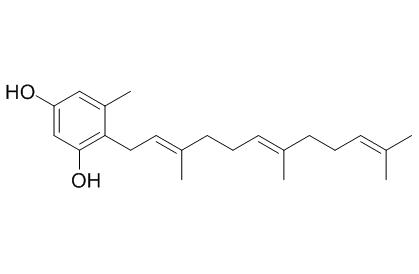Neogrifolin
Neogrifolin is a potential candidate for osteosarcoma, it can induce concentration- and time-dependent suppression of proliferation and induce apoptosis in U2OS and MG63 osteosarcoma cell lines; it exhibits inhibitory activity against nitric oxide (NO) production stimulated by lipopolysaccharide (LPS) in RAW 264.7 cells with the IC50value of 23.3 microM. Neogrifolin possesses antimicrobial activities against Bacillus cereus and Enterococcus faecalis, the MIC values of 20 and 0.5 microg/mL, respectively.
Inquire / Order:
manager@chemfaces.com
Technical Inquiries:
service@chemfaces.com
Tel:
+86-27-84237783
Fax:
+86-27-84254680
Address:
1 Building, No. 83, CheCheng Rd., Wuhan Economic and Technological Development Zone, Wuhan, Hubei 430056, PRC
Providing storage is as stated on the product vial and the vial is kept tightly sealed, the product can be stored for up to
24 months(2-8C).
Wherever possible, you should prepare and use solutions on the same day. However, if you need to make up stock solutions in advance, we recommend that you store the solution as aliquots in tightly sealed vials at -20C. Generally, these will be useable for up to two weeks. Before use, and prior to opening the vial we recommend that you allow your product to equilibrate to room temperature for at least 1 hour.
Need more advice on solubility, usage and handling? Please email to: service@chemfaces.com
The packaging of the product may have turned upside down during transportation, resulting in the natural compounds adhering to the neck or cap of the vial. take the vial out of its packaging and gently shake to let the compounds fall to the bottom of the vial. for liquid products, centrifuge at 200-500 RPM to gather the liquid at the bottom of the vial. try to avoid loss or contamination during handling.
Natural Product Communications2020, doi: 10.1177.
Antioxidants.2022, 11(4), 67.
Appl. Sci.2023, 13(2), 860.
Appl. Sci.2020, 10(20),7374.
J AOAC Int.2024, qsae028.
Int J Mol Sci.2023, 24(7):6360.
Viruses2023, 15(6), 1377
Front Pharmacol.2017, 8:673
Mol Immunol. 2016, 78:121-132
Talanta Open2023, 7:100227
Related and Featured Products
Planta Med. 2010 Feb;76(2):182-5.
Antibacterial compounds from mushrooms I: a lanostane-type triterpene and prenylphenol derivatives from Jahnoporus hirtus and Albatrellus flettii and their activities against Bacillus cereus and Enterococcus faecalis.[Pubmed:
19644795 ]
METHODS AND RESULTS:
Antibacterial bioassay-guided fractionation of two American mushroom species, Jahnoporus hirtus and Albatrellus flettii, led to the isolation and identification of their major antibacterial constituents: 3,11-dioxolanosta-8,24( Z)-diene-26-oic acid (1) from J. hirtus and confluentin (2), grifolin (3), and Neogrifolin (4) from A. flettii. Compound 1 is a new lanostane-type triterpene. All purified compounds were evaluated for their ability to inhibit the growth of Bacillus cereus and Enterococcus faecalis using standard MIC assays. Compounds 1- 4 demonstrated MIC values of 40, 20, 10, and 20 microg/mL, respectively, against B. cereus and MIC values of 32, 1.0, 0.5, and 0.5 microg/mL, respectively, against E. faecalis.
CONCLUSIONS:
Thus, one novel compound and three others were shown to possess antimicrobial activities against these gram-positive bacteria employed as surrogates for more virulent and dangerous pathogens.
Bioorg Med Chem. 2006 Jan 1;14(1):164-8.
Grifolin derivatives from Albatrellus caeruleoporus, new inhibitors of nitric oxide production in RAW 264.7 cells.[Pubmed:
16169234 ]
METHODS AND RESULTS:
Two new farnesyl phenols named grifolinones A and B, together with known grifolin and Neogrifolin, were isolated from methanolic extract of the inedible mushroom Albatrellus caeruleoporus. Their structures were characterized by a combination of 2D NMR, MS, IR, and UV spectra.
CONCLUSIONS:
Grifolinone B was composed of two grifolin molecules, which were connected by a C-C bond.
Grifolinones A and B, grifolin, and Neogrifolin exhibited inhibitory activity against nitric oxide (NO) production stimulated by lipopolysaccharide (LPS) in RAW 264.7 cells with IC50values of 23.4, 22.9, 29.0, and 23.3 microM, respectively.
Int J Clin Exp Pathol. 2015 Feb 1;8(2):1154-64.
Apoptosis prediction via inhibition of AKT signaling pathway by neogrifolin.[Pubmed:
25973001 ]
Neogrifolin, a natural biologically active substance isolated from the edible bodies of the mushroom Albatrellus confluens, has been shown to possess several pharmacological properties. No studies were investigated against osteosarcoma cancer.
METHODS AND RESULTS:
Hence, in this study, we investigated the apoptosis-inducing effects and the mechanisms of Neogrifolin on human osteosarcoma cells. Our results demonstrated that Neogrifolin induced concentration- and time-dependent suppression of proliferation. Further, induction of apoptosis in U2OS and MG63 osteosarcoma cell lines were also observed. Neogrifolin induced the release of cytochrome c accompanied by activation of caspase-9, caspase-3 and cleavage of poly (ADP-ribose) polymerase (PARP). In addition, z-VAD-fmk, a universal inhibitor of caspases, prevented caspase-3 activation and PARP cleavage and inhibited Neogrifolin-induced cell growth inhibition. Furthermore, Neogrifolin treatment resulted in a reduction of phosphorylated AKT level, FOXO transcription factor, and glycogen synthase kinase 3 (GSK3). Knockdown of GSK3 with siRNA inhibited the apoptotic effects of Neogrifolin. On the other hand, Neogrifolin treatment also down-regulated the expression of the inhibitor of apoptosis protein (IAP) in both osteosarcoma cells.
CONCLUSIONS:
Collectively, our results suggested that Neogrifolin is a potential candidate for osteosarcoma.



